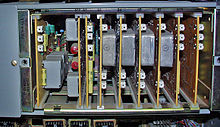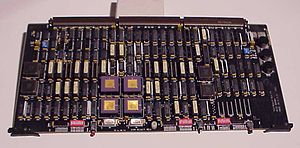- Multi-frequency receiver
-
Multi-Frequency signalling, (MF), is similar to the European version, CCITT Signaling System 5, (SS5). The original format was five tones used in pairs. This later evolved to six tones. Because its six tones are used only in pairs, this signaling format is sometimes referred to as "two-out-of-five code" or "two of six."
 DTMF receiver, late 1960s, in a crossbar exchange
DTMF receiver, late 1960s, in a crossbar exchange
Multi-Frequency receivers have been present in US telephony at least since the late 1940s. In 1940s technology, receivers in 4XB and similar equipment used vacuum tubes. Later ones used RC filters and transistors. Digital filters became commonplace in electronic switching systems of the 1980s. For example, in 5ESS switch such jobs were done by DSPs in the Global Digital Services Unit (GDSU).
Contents
Receivers
One example of an MF receiver built 35 years after the format's original US use is a Digital Signal Processor (DSP) based printed circuit card designed at Computer Consoles Inc. (CCI) in Rochester, NY. The MFR was a service circuit module developed as part of the companies digital telephony switching system. The main function of the card was the processing of incoming digital audio to detect the presence of various voice-band tone base signaling systems present during a call connection. The CCI digital switch was deployed as part of the Digital Audio Intercept System (DAIS II), Automatic Voice Response (AVR), and Interactive Voice System (IVS) products. The initial MFR board, MFR-I, is notable for being designed in early 1983 prior to Texas Instruments officially announcing the TMS320C10 DSP April 8, 1983.
Variants
- MFR-I:
- This printed circuit card, designed by Mark A. Indovina, was introduced in 1983 and contained a single TMS320C10 16-bit fixed point DSP chip operating at 20 MHz.
- MFR-II:
- This printed circuit card, also designed by Mark A. Indovina, was introduced in late 1985 and contained two TMS320C25 16-bit fixed point DSP chips operating at 40 MHz.
- MFR-III:
- This printed circuit card contained two TMS320C30 32-bit floating point DSP chips operating at 40 MHz. Although a prototype was designed and tested, this card never went into volume production.
Features
- The MFR firmware, written entirely in TMS320 assembly language due to the poor efficiency of DSP C compilers at the time, was capable of decoding multiple channels of PCM digital audio while detecting the following signaling systems:
- MF, Multi-Frequency Tones
- DTMF, Dual-Tone Band, Multi-Frequency Tones
- Call Progress Tones
- Other system audio frequencies as needed for on-line, and off-line system testing
- A highly optimized version of the Goertzel algorithm was used as part of the firmware's frequency detection algorithms.
- Due to the tight timing involved in the designs, controlled impedance printed circuit board design techniques was introduced with the MFR-I layout in 1983.
References
- The 5ESS Switching System (The AT&T Technical Journal, July–August 1985, Vol. 64, No. 6, Part 2)
- Multi-Frequency Pulsing in Switching (AIEE Transactions, Volume 68, Part 1, 1949, pp. 392–396)
- Multi-Frequency Pulsing in Switching (Electrical Engineering, June 1949, pp. 505–510)
Categories:- Telephony signals
- Telephony equipment
- MFR-I:
Wikimedia Foundation. 2010.

